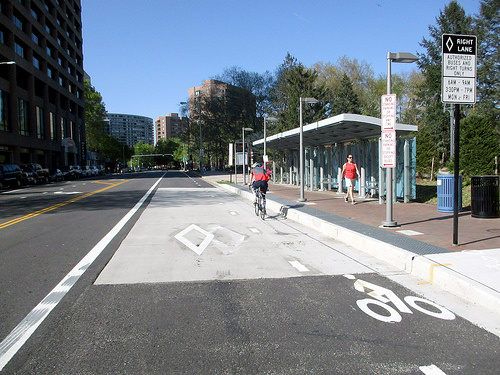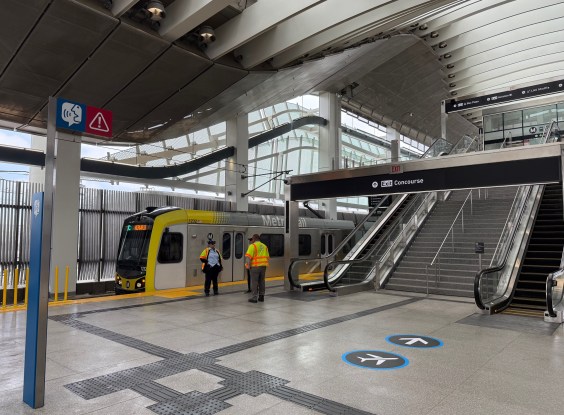Amazon's reported choice of Crystal City, Virginia, for one of its two second headquarters gives the online retailer two key things it emphasized during its search: Strong transit and access to "talent."
The would-be HQ2 location is served by both the Blue and the Yellow lines of the D.C. Metro. The station also serves commuter rail to Virginia's more distant suburbs. It is less than four miles south of downtown Washington, D.C. and within walking distance of Reagan National Airport.
About 60,000 currently work in Crystal City — far more than the 22,000 who call it home. Amazon will add tens of thousands of workers to the mix — some of whom will likely want to reside there, too.
The city appears ready.
Just last week (hmm, nice timing), Arlington approved upgrades to the station that will add a second platform and a second entrance, allowing more frequently train service. The two buildings Amazon is reportedly eyeing, are both a short walk from the station.
In addition, Arlington County has been building a bus rapid transit system (shown above) that connects Crystal City with Alexandria.
SIDEBAR: HERE'S OUR REPORT ON AMAZON'S OTHER HQ2 SITE IN QUEENS, NY
Good transit is one part of the mix. The other is a smart workforce. In 2016, metro D.C. had the highest educational attainment of any big city region. The combination of good workers and good transit is obviously attractive — but Crystal City, where Amazon already has a satellite office, offered additional benefits, experts said.
"This is not your usual suburban office park," Payton Chung, director of the Center for Capital Markets and Real Estate at the Urban Land Institute, told Streetsblog. "It’s in a technically suburban location but it’s much higher density and it is transit oriented."
Crystal City was a low-density semi-industrial area until the 1970s, when it became connected with Metrorail. After that, there was rapid development — mostly high-rise office. It's not very walkable, composed mostly of "superblocks." Urbanists complain it lacks street facing retail. Instead, Crystal City has a large underground mall.
It also has a fair amount of excess office space, Chung said.
Employment in the area has fallen by as many as tens of thousands of employees as employers such as the Department of Defense and the U.S. Patents Office have decamped for more distant suburbs, he added. But the area is also becoming a hip enclave — a "Brooklyn" of the D.C. suburbs, the Times reported two years ago.
It's also fortuitous that Arlington County has made a major commitment to transportation demand management. The county requires employers to limit car commuting by offering alternatives — like free transit passes — and by discouraging driving by, for example, charging for parking. That could help keep the traffic situation under control, says Chung.
On housing, however, it's another story. D.C. hasn't been adding enough infill housing to meet current demand.
Alex Baca of the D.C.-based Coalition for Smarter Growth said Amazon's expansion into the region should result in zoning changes to expand urban housing development. The Washington Post reports the D.C. region has already been falling well-short of its goal to add 267,000 new housing units by 2026 — and Amazon's 25,000-plus workers will add additional pressure.
About 1,200 units of housing — mostly high-rise — are already in the works for Crystal City, according to the local real estate site DC Urban Turf. But that's not gonna cut it, said Baca.
Expanding housing options has been political unpopular, but it will be necessary if D.C. wants to keep housing affordable, she told Streetsblog.
"Amazon just exacerbates a lot of things we’ve been pressing on for a long time: Building more housing, especially more affordable housing, and building more bus and trail," she added.
The choice comes after the online retail giant engaged in a year plus-long highly-publicized search for a second headquarters — soliciting proposals from 238 localities and getting plenty of promises of subsidies — only to land on Long Island City in western Queens and the Washington, D.C. suburb for new hubs.
As such, there are many skeptics of the Seattle-based company's process, which ended up naming two places where it already has its largest outposts — two places that already have robust job markets as well as pretty severe housing and traffic pressures that will only increase.
Which can, of course, be summed up in one handy tweet:
To recap:1. Amazon announces nationwide search for HQ22. Cities offer billions in taxpayer subsidies3. Amazon leverages those offers to get hundreds of millions in subsidies from NY & DC areas, its biggest East Coast offices now4. Amazon picks NY & DChttps://t.co/DNzzVIbwmp
— Mike Rosenberg (@ByRosenberg) November 6, 2018
The choice of Queens and Crystal City dashed the hopes of smaller inland cities such as Columbus, Ohio, and Denver, which have been competing for the company's $5 billion investment.






